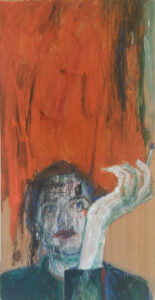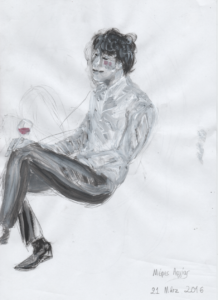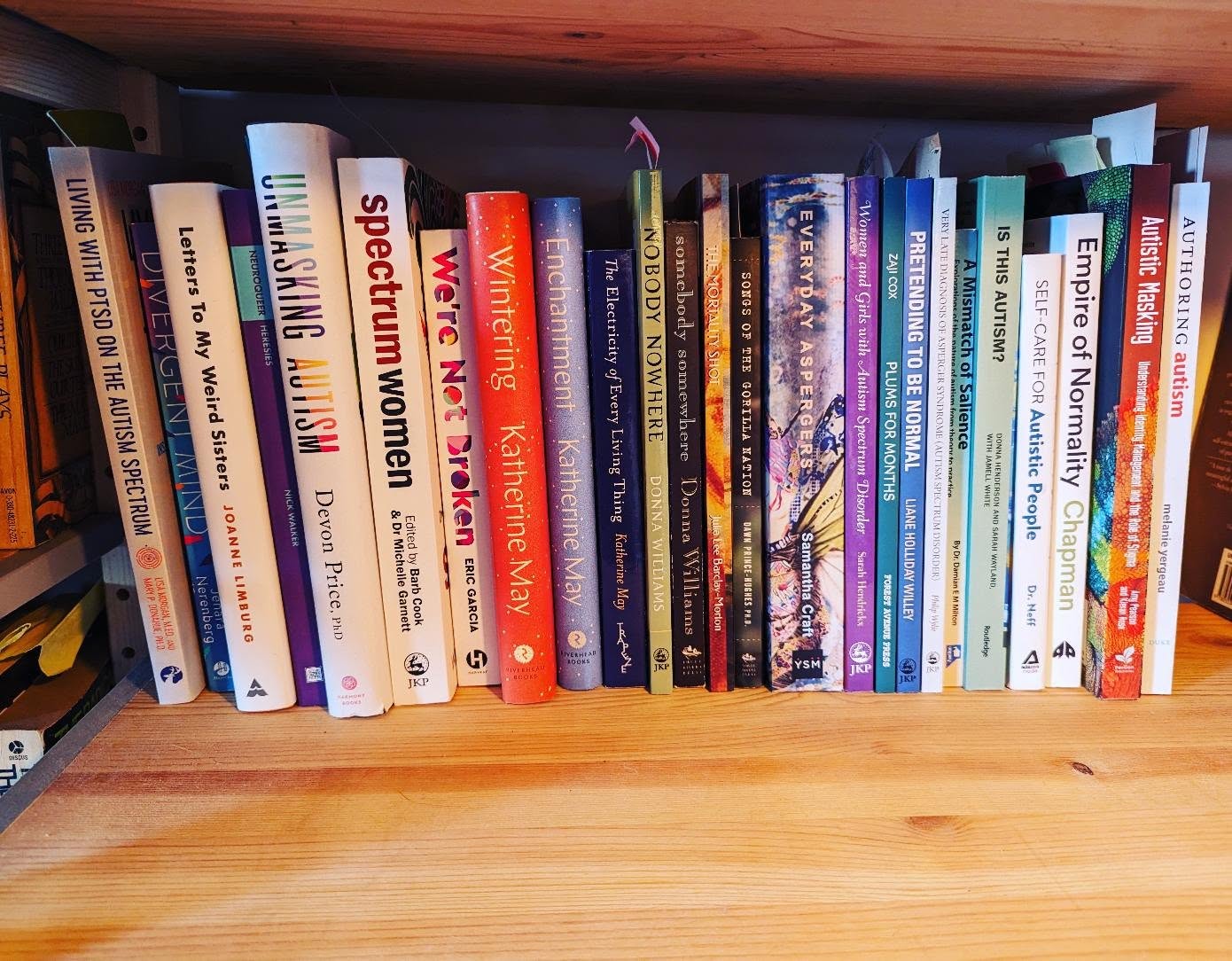
JULIA LEE BARCLAY-MORTON – YOGA, WATER AND REWRITING AUTISM
I interviewed writer Julia Lee Barclay-Morton about her experience of autism. Julia began as an experimental dramatist in New York, moving to the UK to



Artist Idledaze and author Leslie Tate exchanged ideas about their creative processes, and how much their work is connected to being non-binary .
Leslie: So, where do we start if we’re relating creativity to stepping outside the gender box?
Idledaze: It’s good to speak as queer artists, but it doesn’t have to be queerness that’s the main point of our artworks. So I don’t think queerness manifests in an overt way in my work. Androgyny is perhaps the most obvious manifestation.
I also think there’s the theme of men who look fragile in my work, which is a gendered topic, but with its own niche. For instance in my picture ‘Crossed Out Ready’.

Leslie: That image really speaks to me. Fragile Men is an excellent title for me to try for a poem, inspired by your picture:
Fragile Men
The angle of his arm and thrown-out hand
is a bird of paradise flower where the sunbirds land.
She’s in orange and black. In a blue-green softness
of love burning down, the hotness
and ache of blanched skin are he/she/they
seen through a glass darkly. If this is the way
of all flesh, root and flower of unnamed self,
then with what wings do angels dance their death?
Leslie Tate

Idledaze: My creative process goes like this – I have a reservoir of images in my mind. This reservoir gets filled by what I see and what I notice every day, I also keep photos and bits of paper of things that inspire me. When sitting down to draw, sometimes I start with a clear reference, like this picture which is based on a still of a movie starring David Bowie. I do a sketch first, using the grid method, to be sure I’ve gotten proportions and placement right. Once that is done, I feel more confident adding color. It just ‘feels’ right to add splashes of color in unexpected places, when I’ve reached this stage.

Sometimes, there are ideas for drawings that just emerge as I sit and let my hand flow on paper, like this content, solitary person with a wine glass who doesn’t care about having furniture.
What I’ve learned over time, is how to know when stop working on a piece. When it feels like I am going through the motions just to get a part of the background filled, it is time to pause and think – what if I don’t? Sometimes I need to keep at it, other times, doing less (the absence of color or background furniture) yields a more meaningful result and reveals the material underneath, increasing the impact of the actual subject.

Leslie: My work begins facing a blank sheet of paper. Filling up that space can be a struggle. I might start by searching through my memory for an incident to write about, or monitoring my mind closely as it throws up words and ideas, but usually my attempts to consciously direct the creative process don’t work – although I have to make the effort and start somewhere. So I’m driving myself, while letting go; forcing out words while groping in the dark.
I can go through several false starts over a period of hours involving endless stabs at words, words reversed and looked up in the Thesaurus, as well as phrases tried, modified and discarded – so that it takes me hours or even days before I have the crucial first few words. Those first few words are like music: they lead me into a sound-world, a landscape of feeling that has its own character & psychology, and though I continue to amend, edit and discard as I write there’s a sound/sense unity that leads me on.

When I’m ‘finished’ I pare it down, weed out repetitions, insert transitions and sometimes cancel whole sections and start again. I rely on my knowledge of literature as my compass but even so I can’t be sure to find the right ending or any coherence without cliché or repetition. It’s dangerous, exhausting, frustrating, unpredictable and leads me to being forever critical of my own work. It’s almost as if I’m willing in something deliberate & artificial, shoehorning in the depths and layers I look for in other people’s writing. There are no Gods directing me (perhaps that goes with being a Quaker) and no significant external recognition, but I have a secret feeling, at the same time, that there’s something uniquely beautiful in what I’m doing.
If my work is gendered it’s like me: socialised male, spiritually female, with a desire to speak about the vulnerability we all feel behind the mask.
You can see more of Idledaze’s images on Instagram here. You can find short introductions to the various projects Idledaze is involved in here.
Next week I interviewed poet, art critic and environmentalist Nancy Campbell about her Arctic residencies, her climate change projects, and her work supporting threatened cultures.
ABOUT LESLIE TATE’S BOOKS:

I interviewed writer Julia Lee Barclay-Morton about her experience of autism. Julia began as an experimental dramatist in New York, moving to the UK to

I interviewed Gillean McDougall from Glasgow, who edited the collaborative projects Honest Error (on Charles Rennie Mackintosh and his wife Margaret Macdonald) and Writing the

I interviewed French writer Delphine de Vigan, whose book, No et moi, won the prestigious Prix des libraires. Other books of hers have won a clutch

I interviewed Joanne Limburg whose poetry collection Feminismo was shortlisted for the Forward Prize for Best First Collection; another collection, Paraphernalia, was a Poetry Book Society Recommendation. Joanne

I interviewed Katherine Magnoli about The Adventures of KatGirl, her book about a wheelchair heroine, and Katherine’s journey from low self-esteem into authorial/radio success and
| Cookie | Duration | Description |
|---|---|---|
| cookielawinfo-checkbox-analytics | 11 months | This cookie is set by GDPR Cookie Consent plugin. The cookie is used to store the user consent for the cookies in the category "Analytics". |
| cookielawinfo-checkbox-functional | 11 months | The cookie is set by GDPR cookie consent to record the user consent for the cookies in the category "Functional". |
| cookielawinfo-checkbox-necessary | 11 months | This cookie is set by GDPR Cookie Consent plugin. The cookies is used to store the user consent for the cookies in the category "Necessary". |
| cookielawinfo-checkbox-others | 11 months | This cookie is set by GDPR Cookie Consent plugin. The cookie is used to store the user consent for the cookies in the category "Other. |
| cookielawinfo-checkbox-performance | 11 months | This cookie is set by GDPR Cookie Consent plugin. The cookie is used to store the user consent for the cookies in the category "Performance". |
| viewed_cookie_policy | 11 months | The cookie is set by the GDPR Cookie Consent plugin and is used to store whether or not user has consented to the use of cookies. It does not store any personal data. |